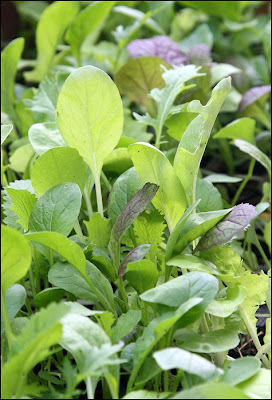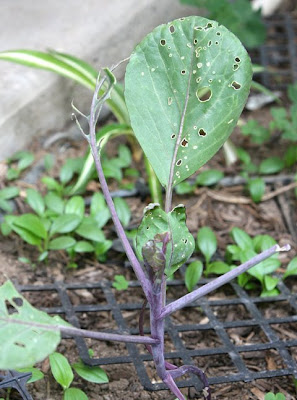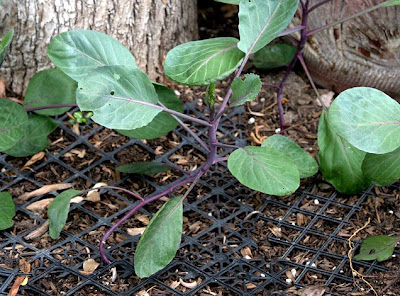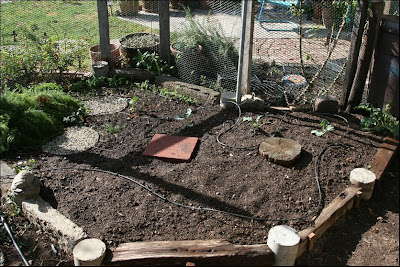Saturday, December 27, 2008
We've moved!
Rain and....Hail!

Our dear daughter came running into our room at midnight to inform us that it was hailing outside. Her desire, as is all our kids, is to have it snow here....something it has not done significantly for ten years. Every once in a while we get a bit of frost that lingers in the morning and if you squint and turn your head just the right angle you can imagine what it would be like to have snow on the ground here in the Central Valley. But snow to the degree that my children would appreciate comes maybe 2 or 3 times in a lifetime. The last great snowstorm of '97 closed down schools (all 2 inches of it:). We drove around town taking pictures of snowmen and kids skiing (ok, being towed by their parents) on their front lawns. Great day!
But I digress. Last night it was hail and the suggestion of snow....today its sunny and the dream has disappeared. Oh well. The garden has survived and tho things were a bit droopy first thing in the morning.....
...all plants are alive, upright, and thoroughly enjoying the sunny afternoon....yippee yahoo.
More Lettuce?

Yesterday was the first of December (son’s birthday…yea!) and I planted another pkg. of lettuce seed. This is the first time I’ve sowed a second crop of greens and tho it is quite foggy and a bit chilly outside I’m hoping that some of what went into the ground will germinate and we can have a few more baby green salads this winter. Our other beds of lettuce and mixed greens are doing well, the black-seeded Simpson and Romaines are about 6 inches tall and still quite tender. The Asian baby leaf (in photo) came up fast and got tough fairly quickly. Next year I will plant those more sparingly, we couldn’t eat them fast enough and they were much more tasty as babies.
Powdery Mildew

We are having a bit of an issue with powdery mildew on our ornamentals. These are our little calendulas growing by the broccoli out in the front yard garden. We have had such a warm fall (see garlic post :) and powdery mildew is especially prevalent in these particular situations…..

Garlic ...Maybe

To form cloves, garlic must be exposed to temperatures below 41 F (5 C). Thus, if planted too late in the spring, garlic will tend to form large onion-like bulbs instead of individual cloves. In the North, garlic is normally planted in October so that it can establish roots before winter and really take of in the spring. Southern gardeners can only plant garlic if they know the temperature will dip low enough. Often, they can wait until November or December to plant.
This is only our second attempt at growing garlic. The first time it went into the ground at the beginning of May; I guess I now know why that didn’t work out so well. I figured this year we were going to get it right. Maybe I should have paid a bit closer attention to the weather channel my daughter always consults before clothing herself….or maybe I should just ask my daughter :)

We have the garlic planted in one container, another spot by the lavender, and a row by our side fence. I wanted to try a few different locales to see which ones were the most productive, now it may be moot...sigh. At this point I guess only time will tell. It’s so wonderful outside, sunny and warm, that I probably shouldn’t be hoping for a quick drop in temperatures…but I am.
New Life

There is something incredibly satisfying about going out in the garden and discovering the first signs of life on new plantings. I start looking the day after I sow seeds….despite knowing that at least a few days will have to pass before nature does it’s thing and this small, hard, shell of a seed can burst from it’s cocoon and push it’s way up thru the soil to greet the sunshine. I am tickled by the green that arises from seemingly insignificant pods of brown. Many times I have gotten excited checking out the raised beds only to discover that for several days I have been cheering on a weed (or in the summer - a morning glory…virtually a weed at our house). No worries…usually the real plants are not far behind.
Today, the onions are up and reaching for the sky. This is one of the Com Reds that were planted last week. The shallots are starting to poke their way thru the composted soil, but are not quite as speedy as the little red guys. I know it will be months before they are harvested but for today I am happy just to see sprouts and know there is hope for our little patch of onions.
Slow Food

One of the many reasons Steven and I are dragging our family along the organic/grow-your-own food road is the abysmal state of the American diet and the long term health consequences of continuing down that path. How sad that the ‘Greatest Nation on Earth’ is now foisting upon the rest of the world our propensity to consume large amounts of sugar, fat and salt. I was dismayed to read the following article out of Greece about the consequences of a fast food diet replacing the heart healthy, and highly acclaimed Mediterranean diet. In countries famous for their diet of olive oil, fish and fresh veggies, the rates of obesity and diabetes are skyrocketing. Call it the McDonaldization of the world, call it whatever you want, we don’t want anything to do with it.
...I would like a flying pony for my birthday...sigh.
The Seeds of Suburban Sharecroppers

This life we now lead started years ago. It is as much the growth of our marriage and life together as it is our desire to eat better and healthier. We thought it might be nice to go back and write about some of the influences that brought us to where we are now. Some things have been forgotten and some remain. Maybe we will remember some that shouldn’t have been lost. Though we didn’t have the current name, the beginnings of our present endeavors came after we were first married. We had a book on the shelf called The Integral Urban House. This was a project of the Farallones Institute in Northern California. It was a normal urban house in Berkley, CA that had been changed and converted into a self sustaining urban farm. We started to incorporate some of the ideas from this book. We started slowly with a compost bin and garden around our little rental house in Visalia. The gardens were double-dug and we planted some vegetables in that first experiment. The double-digging idea came from another book, How to Grow More Vegetables Than You Ever Thought Possible on Less Land Than You Can Imagine: A Primer on the Life-giving Biodynamic/French Intensive Method of Organic Horticulture by John Jeavons. Double digging has become one of the staples of our gardens. When we convert a piece of ground to garden, that is what we do to start. Double-Dig, compost, manure at times, gypsum, peat moss and lots of shovel work.
...to be continued...
Onions
Planted onions and shallots this week. We love onions, and by ‘we’ I mean Steve and I. The kids are not quite sure about them and tho I put them in tons of recipes I usually dice them as tiny as possible so no one will notice. Lately I’ve been substituting shallots for onions in most recipes because they get more tender after cooking and therefore more easily disguise-able (is that even a word? :) Part of being a good parent is learning the fine art of subterfuge.
Years ago when we first switched over to organic milk, the kids were unsure of how this alien milk would taste and hesitant to drink it. So for about a month I poured organic milk into a couple of normal milk cartons that I had saved. After a month of drinking it without noticing, we told them they had been drinking the organic stuff and all was well from then on (neener neener). I also used to put tofu in quite a few dishes without informing the young ‘uns. I distinctly remember the evening Wilson found out he had been eating it in my enchiladas….. said he thought it was cheese. Months later, after finding a tiny piece of soy in the eggrolls, he asked me if I had put mushrooms in them. When I told him that it was tofu, he was relieved. Maybe our kids just need to learn to eat with blindfolds on.
But I digress. Onions, shallots, and garlic. These antagnonists of peas and children everywhere went into the ground this week for our winter garden. I have grown onions only 2 other times so I am still a novice….still plenty of mistakes to be made. I got my sets by mail order - Comred onions, Dutch Yellow and French Red shallots, and California hard and soft-necked garlic. No pics of the garlic, they went in the ground last week and I forgot to take photos.
Here is the onion bed….inter-planted with 4 broccoli plants and surrounded by mixed greens and an unfinished concrete pathway (long boring story)
Eek! We have bugs...

...Specifically we have cabbage loopers… nasty, voracious little buggers. I wish I’d take a before pic of these purple cabbage plants; they were quite healthy …were being the operative word in this case. 3 days ago they looked a lot like the ones in the Cat guard post…those are in front yard and for some odd reason completely escaped the onslaught.

—BT….Bacillus thuringiensis var Kurstaki, a naturally occurring bacterial insecticide. After consuming Bt, caterpillars stop eating and die within a few days. Controls tent caterpillars, gypsy moths, cabbage loopers, tomato hornworms and other leaf-eating caterpillars. Derived from natural ingredients and does not remain in the environment for long. May be used up to the day of harvest.
I was so intent on squishing the invaders that I forgot to get a photo of the green monsters. More info on loopers can be found in this article from Organic Gardening. Hopefully the plants will recover and I can post pics of the patients well on their way to a long and healthy life….until we decide to eat them :)
Lettuce!

We picked the first greens of the season…Yippee, Yahoo! Always a treat to start gathering the baby lettuce for the first yummy salad from the fall crop. Here in the Central Valley we can’t grow lettuce in the summer…well, we but it’s a LOT harder and frankly not worth it. I just buy Earthbound Farms during the months of hell and we eat more zucchini. With temperatures around 110 for days on end it fries the poor greens; ours start bolting when the temp gets into the high 80’s! Our climate, however, does allow us to plant lettuce several times from fall thru early spring so we theoretically can have baby greens for 7 months of the year. I tend to be lazy, plant a couple different varieties over the course of a few weeks in Oct. and then eat it all winter at whatever stage it happens to be. This year we are going to experiment with staggered plantings because the young growth is so tasty and we just want to see what happens. I’ll keep you posted on the results. The plan is to plant a small bit on the first of Dec. and then again in Feb. and March….depending on the weather and the soil conditions. My research (aka googling - see tips) says these should germinate at temps as low as 40 degrees at night, 60 during the day…so we’ll be following the weather reports a bit more closely than usual. This salad is mostly Black-seeded Simpson, because it grew the fastest, served with goat cheese, pecans and a glass of wine…not optional.

Cat Guards

We have (choke choke) 11 cats; I’m not sure why, I wish I did, but I don’t. Cats are wonderful, snugly, sweet, independent, mischievous, and on occasion, naughty animals….and we love them. But cats and gardens don’t always mix. Many times we have had to replant beds and shore up plants knocked over by playful kittys, not to mention the digging involved when felines need to ‘do their business’ and decide to do it on a newly planted garden bed. Several years ago we came up with the idea of using plant trays around transplants as well as on top of seed beds to discourage our cats from using the garden as a big litter box.

I usually cut the edges off and secure with drip irrigation anchors. Most of the time I just leave them in all season; occasionally we will remove them once a bed is established.

I used to turn the trays in to our local nursery for recycling, now I just keep them and add to our collection of plant protectors. We have also used metal shelving (this green one was found in the neighbors trash) and old refrigerator shelves.


Wednesday, November 19, 2008
Companion Planting
The best info came from Seeds of Change , Garden Toad , and Mother Earth News - which is actually an excerpt from the wonderful and ’soon to be purchased for our reference library’ book …
From what I understand, onions will inhibit the growth of peas; there doesn’t seem to be any negative effect on the onions. Since the nearest I planted onions to peas is about 4 ft. I will keep track of how these little guys respond and compare them to the ones in beds where onions are absent….I’ll keep you posted.
Another tidbit on companions comes from Sheriden Gardens which gives info on the benefits of certain herbs inter planted with veggies.
Originally posted on October 29th, 2008
Monday, November 17, 2008
Peas, Peas, and More Peas

We planted peas everywhere this year....


...here they are poking up between our 2-yr. old orange trees....

...and here they are along the ‘dog’ fence in front of broccoli and soon-to-be-planted shallots. I need to do a bit of research on how far away peas need to be from shallots. They’re not good companions but I’m not sure why or at what distance they will start bickering….I’ll let you know :)

More info on Peas, specifically geared toward CA but applicable to pretty much any warm winter climates, can be found on the UC extension web site. Our Central Valley is just much too hot for summer plantings and tho it will get below freezing in the winter, it’s not consistent and when it snows here, we cancel school and write about it in the newspaper :)
The following is an excerpt on weather conditions for growing peas ——
Edible pod peas require consistently cool growing conditions and do not produce well in hotter areas. Peas are cool-season vegetables with optimum growing temperatures between 55′ and 65′ F (13′-18′ C) in colder growing areas where peas are grown year-round, growth and development are considerably slower during winter months. Flowering and pod set are sometimes interrupteded by frosts, but plants recover and produce normally if frosts are brief.
Plants may tolerate some high temperatures during vegetative growth, but flowering is initiated when plants are smaller. Pod and seed development is so rapid that quality and yield are reduced by high temperatures. High temperatures in desert and inland growing areas severely restrict the growing season. In milder areas, yields and quality may be adversely affected for short periods by unusual warm weather.Friday, November 14, 2008
Compost

This is one of our backyard gardens; it’s actually the original garden that we started probably 15 years years ago. The fence is to keep the dogs out …wish we could say the same for the cats .

And this is one of the reasons we feel we are out-growing our little home garden. We have only one compost pile which we add to all year long, grass clippings, vegetable waste from kitchen, yard cleanups, urine (icky but a very good fertilizer …can actually be put straight into the garden diluted with water at a 10/1 ratio). Unfortunately, when we need to use the compost, the good stuff is at the bottom of a very large pile. We started a second pile this year with the intention of only adding to that pile, letting the other decompose so it would be ready to use next summer. Unfortunately, our budget once again reared it’s ugly head and we decided we needed the wonderful compost that was surely resting at the bottom of our original pile, plus the 2nd pile was taking up valuable garden space, so……in we go.
The top part of the pile had to be move temporarily, and then as we got down to the brown, dirt looking stuff we started sifting. We made a sifter thingie (technical term) out of heavy duty wire mesh that we folded up about 3 inches on the sides. The compost is then shoveled into the sifter, hand sifted and the sticks and bigger pieces remain to be thrown back into the pile when the box is emptied. It’s a long, strenuous process and though we ended up with probably $100 worth of rich organic compost, a change must be made. Ideally, we will be looking at building 3 bins in the new garden and moving the compost 3 times a year. This will aerate the piles and provide a point where two piles are not being added to, allowing them to decompose. No sifting should be necessary in the 3-bin system; we are simply too old for this kind of effort.
ps. if you were wondering about the No allo written on the side of the compost bin…we used the wood from an old fort that our sons had built and painted….No girls allowed.
Front Yard Fun


It may just be the smallest front yard in town but we are determined to get as much produce out of it as possible. We also have peas planted along the picket fence behind the broccoli. More pics will be posted as veggies grow bigger and taller.

The ’stone’ is broken concrete that we chisel to look a bit softer. You can get the concrete just about anywhere; most cities are constantly tearing up sidewalks and the waste just goes into a landfill. We’ve even gotten our city workers to drop it off in the driveway…one of the joys of living in a small town.
We have a total parcel size of 50′x150′ but with several trees and out-buildings (storage shed, son’s studio apartment) plus quite a bit of concrete (basketball court/ pool pad) the usable garden space is at a premium. In past years we have had to listen to complaints from our kids as every spring we steal a bit more of their play space…but since the youngest is close to 15 years old now, and all of them are busy with sports, school, and jobs, the consensus lately seems to be anything that lessens the amount of lawn needing to be mowed is a good thing.
One less patch of Grass

This is a picture of what was a patch of grass that we, actually the boys took turns, pulled out and planted with green beans and tomatoes. That was at the beginning of the summer. Since then we pulled out the last of the grass in the front yard and planted winter vegetables. Our yard will be the test plot for other places.
The Beginning

Sharecropper… A tenant farmer who gives a share of the crops raised to the landlord in lieu of rent.
We are a family of 6 (though technically 1 son is away at college) who are outgrowing our home garden and have decided to ‘rent’ a plot of land (1/2 acre) in exchange for vegetables grown there. With food prices going up and organic fruit and veggies at a premium, growing safe, healthy food as close to home as possible seemed like a good idea. We live in a small town (pop. 10,000), near a fairly large city (pop. 120,000) in the middle of the Central Valley CA and the amount of uncultivated land is pretty impressive. We have approached a local woman (ok, so she’s a relative) with our idea and are still hammering out the details.
This blog will follow the planning and progress of the project and hopefully our ultimate success in this endeavor. We plan to raise chickens for eggs and eventually for meat, goats for milk and cheese and possibly pigs. In the meantime we will chronicle our continued efforts in our expanding home garden, including our recent change from grass to veggies in the front yard (can’t wait to hear from the neighbors:)
Though we have gardened for years, it was always a luxury more than a necessity. Our efforts allowed us to eat organic homegrown produce but failure wasn’t a concern as we could always suppliment with store bought produce. As our budget tightens we now are taking our ‘farming’ a bit more seriously. What we grow, raise, produce…will be a major part of our diet. We are amatuers setting out on this road and hope to learn and share along the way.
Come with us.









